Homocysteine induces podocyte apoptosis by regulating miR-1929-5p expression through c-Myc, DNMT1 and EZH2
- PMID: 34057794
- PMCID: PMC8564658
- DOI: 10.1002/1878-0261.13032
Homocysteine induces podocyte apoptosis by regulating miR-1929-5p expression through c-Myc, DNMT1 and EZH2
Abstract
Chronic kidney disease (CKD) is a common and complex disease in kidneys which has been associated with an increased risk of renal cell carcinoma. Elevated homocysteine (Hcy) levels are known to influence the development and progression of CKD by regulating podocyte injury and apoptosis. To investigate the molecular mechanisms triggered in podocytes by Hcy, we used cbs+/- mice and observed that higher Hcy levels increased the apoptosis rate of podocytes with accompanying glomerular damage. Hcy-induced podocyte injury and apoptosis in cbs+/- mice was regulated by inhibition of microRNA (miR)-1929-5p expression. Overexpression of miR-1929-5p in podocytes inhibited apoptosis by upregulating Bcl-2. Furthermore, the expression of miR-1929-5p was regulated by epigenetic modifications of its promoter. Hcy upregulated DNA methyltransferase 1 (DNMT1) and enhancer of zeste homolog 2 (EZH2) levels, resulting in increased DNA methylation and H3K27me3 levels on the miR-1929-5p promoter. Additionally, we observed that c-Myc recruited DNMT1 and EZH2 to the miR-1929-5p promoter and suppressed the expression of miR-1929-5p. In summary, we demonstrated that Hcy promotes podocyte apoptosis through the regulation of the epigenetic modifiers DNMT1 and EZH2, which are recruited by c-Myc to the promoter of miR-1929-5p to silence miR-1929-5p expression.
Keywords: c-Myc; DNMT1; EZH2; homocysteine; kidney; miR-1929-5p.
© 2021 The Authors. Molecular Oncology published by John Wiley & Sons Ltd on behalf of Federation of European Biochemical Societies.
Conflict of interest statement
The authors declare no conflict of interest.
Figures
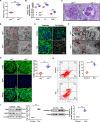
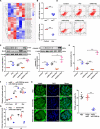
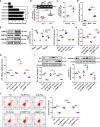


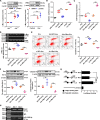
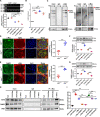
Similar articles
-
miR-30a-5p promotes glomerular podocyte apoptosis via DNMT1-mediated hypermethylation under hyperhomocysteinemia.Acta Biochim Biophys Sin (Shanghai). 2022 Jan 25;54(1):126-136. doi: 10.3724/abbs.2021005. Acta Biochim Biophys Sin (Shanghai). 2022. PMID: 35130620 Free PMC article.
-
[Homocysteine induces glomerular podocyte apoptosis via up-regulation of miR-488-3p expression in MPC-5 mice].Xi Bao Yu Fen Zi Mian Yi Xue Za Zhi. 2022 Sep;38(9):801-806. Xi Bao Yu Fen Zi Mian Yi Xue Za Zhi. 2022. PMID: 36082710 Chinese.
-
Enhancer of zeste homolog 2 participates in the process of atherosclerosis by modulating microRNA-139-5p methylation and signal transducer and activator of transcription 1 expression.IUBMB Life. 2021 Jan;73(1):238-251. doi: 10.1002/iub.2423. Epub 2020 Dec 17. IUBMB Life. 2021. PMID: 33331071
-
DNA methyltransferase 1-mediated CpG methylation of the miR-150-5p promoter contributes to fibroblast growth factor receptor 1-driven leukemogenesis.J Biol Chem. 2019 Nov 29;294(48):18122-18130. doi: 10.1074/jbc.RA119.010144. Epub 2019 Oct 18. J Biol Chem. 2019. PMID: 31628193 Free PMC article.
-
EZH2-H3K27me3-mediated silencing of mir-139-5p inhibits cellular senescence in hepatocellular carcinoma by activating TOP2A.J Exp Clin Cancer Res. 2023 Nov 27;42(1):320. doi: 10.1186/s13046-023-02855-2. J Exp Clin Cancer Res. 2023. PMID: 38008711 Free PMC article.
Cited by
-
Metabolic Homeostasis of Amino Acids and Diabetic Kidney Disease.Nutrients. 2022 Dec 30;15(1):184. doi: 10.3390/nu15010184. Nutrients. 2022. PMID: 36615841 Free PMC article. Review.
-
Suppression of colon cancer growth by berberine mediated by the intestinal microbiota and the suppression of DNA methyltransferases (DNMTs).Mol Cell Biochem. 2024 Aug;479(8):2131-2141. doi: 10.1007/s11010-023-04836-7. Epub 2023 Aug 28. Mol Cell Biochem. 2024. PMID: 37639199
-
The expression of apoptosis related genes in HK-2 cells overexpressing PPM1K was determined by RNA-seq analysis.Front Genet. 2022 Nov 1;13:1004610. doi: 10.3389/fgene.2022.1004610. eCollection 2022. Front Genet. 2022. PMID: 36386814 Free PMC article.
-
Chromatin modifiers in human disease: from functional roles to regulatory mechanisms.Mol Biomed. 2024 Apr 8;5(1):12. doi: 10.1186/s43556-024-00175-1. Mol Biomed. 2024. PMID: 38584203 Free PMC article. Review.
References
-
- Linehan WM & Ricketts CJ (2019) The Cancer Genome Atlas of renal cell carcinoma: findings and clinical implications. Nat Rev Urol 16, 539–552. - PubMed
-
- Ostrakhovitch EA & Tabibzadeh S (2015) Homocysteine in chronic kidney disease. Adv Clin Chem 72, 77–106. - PubMed
-
- Li S, Qiu B, Lu H, Lai Y, Liu J, Luo J, Zhu F, Hu Z, Zhou M, Tian J et al. (2019) Hyperhomocysteinemia accelerates acute kidney injury to chronic kidney disease progression by downregulating heme oxygenase‐1 expression. Antioxid Redox Signal 30, 1635–1650. - PubMed
Publication types
MeSH terms
Substances
LinkOut - more resources
Full Text Sources
Other Literature Sources
Molecular Biology Databases

